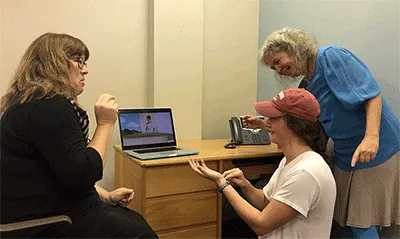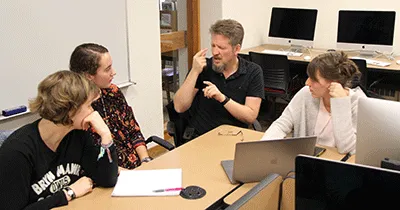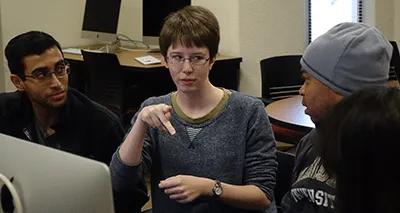Watch: Reading the Signs
When students from Swarthmore and other Tri-Co schools first began collaborating with student signers from Gallaudet University on an e-book for deaf children this fall, the student signers had a radical idea: no text.
“That was a little shocking,” says Sadie Camilliere ’20, a linguistics major from Huntingtown, Md. “How are people going to know what it’s about? But they really wanted this to be sign-language-first e-book, to compel people visually. Just one of the things that, from my hearing perspective, I would not have thought about.”
That distills the heart of Reading Involves Shared Experiences (R.I.S.E.) — a program entirely for and, at times, by deaf children and their families. For the past five years, it has developed an array of e-books and videos to equip parents, providers, and educators with tools to instill the love of reading in deaf children.
“When it comes to being a good reader, the key factor is whether you enjoyed reading books when you were little,” says Professor of Linguistics Donna Jo Napoli, who co-directs the program with Gene Mirus, associate professor of the ASL and Deaf Studies Program at Gallaudet, a university in Washington, D.C. designed to be barrier-free for deaf and hard of hearing students.

American Sign Language Instructor Melanie Drolsbaugh, linguistics major Sadie Camilliere ’20, and Professor of Linguistics Donna Jo Napoli review sign language for a bilingual, bimodal e-book. Photo by Catherine Dunn.
“So these are designed to delight both the deaf children and the adults and siblings who join in the readings,” says Napoli, who was recently appointed a Fulbright Specialist. “That strengthens family bonds and boosts many other aspects of the children’s lives.”
Bilingual, bimodal, and, best of all, free, the books offer combinations of sign language, text, and even voice-overs to maximize engagement. They provide the underserved community of deaf children with early literacy and language-acquisition opportunities, delivering good signing models for the whole family.
But the focus of the program, integrated into Napoli’s Supporting Literacy Among Deaf Children course, is visual. The stars are the local and global signers performing the stories alongside the text.
“You put one of our books in front of a two-year-old, with someone signing right at them, and they’re caught,” says Napoli. “They’re mimicking the signing, and we often see parents joining in, all having fun working on it together.”
That collaborative spirit suffuses the program, which has also included students from Haverford and Bryn Mawr Colleges and the University of Pennsylvania. Specific and altruistic, the class and larger project foster camaraderie.

From left, Shaina Mahoney, a Bryn Mawr College senior; Sadie Camilliere '20; and Marvin Miller and Lisanna Grosso, graduate students at Gallaudet, work on Italian text and sign language for their e-book.
“Repainting pages in Photoshop is fun, but it does not come close to how much I’ve loved signing and sharing stories with our Gallaudet partners,” says Fiona Smith, a junior creative writing major at Bryn Mawr. “They are incredible people to know and work with.”
Adds Casey Ferrara ’14, a research assistant at Moss Rehabilitation Research Institute who has been involved in the project from the start: “My main feeling surrounding this project is gratitude to be given an opportunity to work on a program that I really care about and to learn from a group of people that are just as passionate and much more knowledgeable than I am.”
Ferrara has been studying language from a more clinical/cognitive perspective since graduation, she adds, and does not “often get the chance to directly address problems in the same way.”
Napoli and her students have directly involved deaf children in the process as well, videotaping them telling stories last summer at the Deaf Apostolate in Philadelphia. For those sessions, they encouraged the children to interpret the narratives and make them their own, as opposed to just translating.
“Such a narrow understanding of storytelling would have limited the capacity of the deaf children we worked with, who are unbelievably expressive and imaginative young people,” says Julian Turner ’18, a history major from Mount Juliet, Tenn., who contributed to the project the past two years through independent studies and a summer fellowship, with funding from the Lang Center for Civic & Social Responsibility for faculty-sponsored engaged research.

From left, Sid Ramachandran '20, junior Fiona Smith of Bryn Mawr, and graduate student José Aguilera of Gallaudet collaborate on the American Sign Language and British English for their e-book.
This semester, the signers and Tri-Co students collaborated on the Gallaudet and Swarthmore campuses in groups of four or five, developing illustrations and video to capture imaginations. Camilliere’s group also re-shaped their narrative to show a child visiting a deaf nurse, offering relatability and representation.
“[Napoli] emphasizes that we own our creative decisions,” Camilliere says, resulting in “a highly supportive and collaborative environment.”
“It’s different than any course I’ve taken here so far, and one of my favorites,” she adds. “I feel like every class or even conversation I have with Donna Jo, I come away from it feeling excited and motivated to learn more or work harder.”
Such experiences and the impact of the program itself are something of a happy accident, says Napoli — the byproduct of being introduced to Mirus at a dinner party.
“He heard that I write children’s books, and I heard he had acted in the National Theatre of the Deaf,” she says. “In a snap, we had an interest in creating worlds together.”
Napoli is eager to bring those worlds across the globe as a Fulbright Specialist, an opportunity by which she is “delighted and honored.” She hopes to promote the R.I.S.E. approach with workshops and consultations at international schools while on leave from Swarthmore next year and has received inquiries from schools in Italy, Belgium, Germany, Hong Kong, and New Zealand.
“My fingers would be crossed, except then I couldn't sign,” says Napoli, who views the opportunity as a chance to transcend the academic structure of linguistics and take direct action.
“Through the e-books project, I can advocate for language rights and have the opportunity to be helpful in serving all of these children and their families,” she says. “It’s such a privilege, and I’m at the point in my life in which I want to spend my time in ways that will have as much positive impact as possible, for as many people as possible.”
Swarthmore is investing in its vibrant intellectual culture. Learn how at lifechanging.swarthmore.edu.



